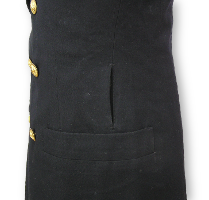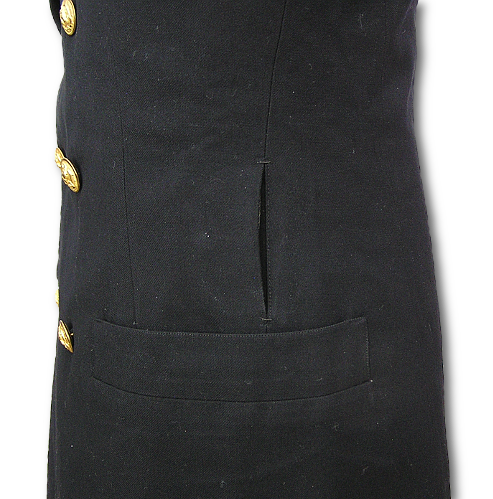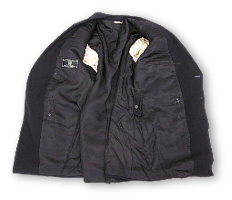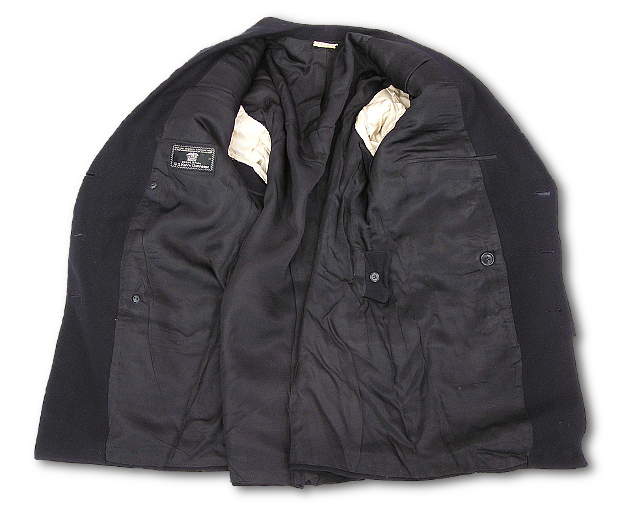U.S. Navy Men's Coats
Officer's, Warrant Officer's, Chief Warrant Officer's Blue Service Coat

The blue service coat was worn by commissioned Officers, Warrant Officers, and Chief Warrant Officers. These officers were required to purchase two coats as part of their minimum prescribed outfit as set forth by Navy regulations in 1941.
| Key Visual ID | Primary Materials | Fasteners | Color | Labeling |
| 1. Rank insignia is present on the lower cuff. 2. Six 35 line (7/8-inch) gilt buttons. 3. A sword slit present above the left hip pocket will distinguish an Officer's coat from a post August 1945 Chief's coat exclusive of rank insignia. | Outer: 15 to 18 oz. Broad Cloth Kersey Elastique Whipcord Serge Lining: Rayon Silk Mohair Serge sleeves with rayon or cotton | Front Closure: Six 35 line (7/8-inch) gilt metal buttons. The coat was to be buttoned using the three buttons on the right. Inside: A single button and flap closure on the left hip to close the sword slit. A plastic anchor button was sometimes located on the left side to fasten the two halves of the coat together from the inside. | Dark Blue (blue-black) a.k.a. navy blue | A Manufacturer's or "Regulation U.S. Navy Uniform" label was located below the right inner breast pocket opening or on the inside nape of the neck. A tailor's label is usually located inside the right inner breast pocket. |
| Treatments | Approx. Contract Run | Preceded By | Replaced By | Companion Garments |
| Unknown. | The blue double breasted service coat was approved March 17, 1919 and it has been produced ever since with minor variations and material changes occurring throughout time. | Blue service coat, model of 1877: This coat was single breasted, with a fly front, stand-up collar, and was trimmed in black mohair braid. The model 1877 had no outside pockets. | Essentially the same coat still remains in service. Post 1950's coats became blacker in color and materials changed as modern synthetic blends became available. For a period the coat had pocket flaps. | Service Cap Garrison Cap Blue Trousers White Trousers White Shirt Black Shoes White Shoes |
(hover for expanded view)
|
In the spring of 1919, the U.S. Navy approved a new officer's blue service coat based upon the type worn by British naval officers. A semi-fitted, notched collar, suit-style design was decided upon because it was felt that this type of garment was more practical for moving about and performing work aboard modern warships than the close fitting, stand-up collar design, which had been in use for the previous 40 years. During the time the new design was being proposed, opposition arose over its adoption because, some felt, that the modern, non-military design too strongly resembled civilian business suits, train conductor uniforms, and that it too strongly resembled the chief petty officer's blue coat. Additionally, it was opined that the new coat was part of a blatant attempt to "democratize" the Navy; eroding the well defined social stratum of the times that separated officers and enlisted men. Despite these objections, the coat was adopted, was well liked, and has continued in service with the U.S. Navy until this day. The officer's blue service coat was a double breasted coat with peaked rolling lapels and an open front. Semi-fitted to allow for comfortable wear, its length was cut to one inch below the crotch line. The rear of the coat was a sack design with a seam running up the center joining the two halves. There were three welt pockets; one on the left breast and one on each hip. Above the left hip pocket was a three and half inch vertical slit to allow the sling of the sword belt to pass through. The cuffs were a closed design without buttons. Blue service coats were made up in many types of material including serge, elastique, whipcord, broadcloth, kersey, and lightweight summer wools. The front closure was a double breasted, button through design that featured three prominent gilt metal buttons on each side of the coat. Regulations stated that the coat should always be closed when being worn, with all three buttons on the right being fastened through. On the face of the button was the traditional navy design of an eagle perched on a anchor surrounded by thirteen stars. Buttons size was 35 line (approx. 7/8 inch). Prior to may 1941 the eagle faced to the left and thereafter faced to the right. Buttons were sometimes attached to the coat using cotter pins or retaining rings so that they could be removed to avoid damage when the coat needed cleaning and pressing. Button pins and rings were usually concealed behind an opening in the lining where they could be accessed when removal was necessary. Blue coats were usually fully lined on the inside with dark blue rayon; however regulations permitted coats to be half-lined or quarter-lined. In addition to rayon, silk was also used as a lining, and cotton was sometimes used to line the sleeves. On the inside left hip there was a button through flap to close the sword slit when not in use. Specifications called for one inside breast pocket on the right side, but often there was an additional inside pocket on the left breast. Some coats had an anchor button on the left inside that was used to secure the right side of the coat against the body by way of the right side middle button hole. Pre-war photos show button holes on both lapels of the blue coat, which largely disappeared before the war. Once the lapel buttons holes were gone, there was little, if any, visible change to coat through the World War II period.
Commissioned Officers, Warrant Officers, and Chief Warrant Officers were required to purchase two blue service coats as part of the their minimum outfit requirement. The blue service coat was worn as part of three different uniform combinations depending on which one was prescribed for wear by the commanding officer; Service Blue A (blue jacket, trousers, and cap), Service Blue B (blue jacket and trousers with white cap), and Service Blue C (blue jacket with white cap and trousers). Rank was indicated on the lower sleeve of the blue service coat by a series of gold lace bands. The sleeve marks (rank stripes) varied in width from one-quarter inches to two inches and extended all the way around the sleeve. Regulations were changed effective January 1, 1944 allowing, as optional wear, sleeve rank markings that only extended around the front half of the cuff. Warrant officers and chief warrant officers wore a broken yellow rank band on their coats. |
The insignia worn above the rank marks indicated whether an officer was a line officer or a member of a corps. A star indicated a line officer (general officer) or any one of a number corps devices that indicated the officer's specialty. Service ribbons and qualification badges were worn above the left breast pocket; ribbons just above the pocket and any badge was worn above the ribbons. The principle types of badges worn by Navy personnel were those authorized for wear by aviation pilots and submarine officers. Officers were responsible for purchasing their own uniforms and maintaining the minimum uniform requirements as set forth by Navy regulations. As a result officer 's uniform items were manufactured and sold by private concerns and thus did not have Navy contract labeling attached to them as did enlisted men's uniforms and field clothing. There was typically a manufacturers label just below the right inside pocket or sometimes on the inside of the coat at the nape of the neck. Manufacturer's labels were numerous, representing garment makers from all across the country who manufactured Navy uniforms. A common wartime label was the "Regulation U.S. Navy Uniform" label, which indicated the garment was produced as part of a subsidized program that offered uniforms at post exchanges and retail outlets at a lower cost.
The tailor's label, usually found sewn in the right inside pocket, could yield more useful information than the manufacturer's label. This label often listed vital data, such as the owners name, rank, size, and the date that alterations were made. When a label has all or some of this information completed, it can be used to help establish a time frame for when a coat was manufactured and used.
In the years following the war, other than a slight lenghthening of the lapels that occurred in 1947, there was very little visible change to the blue service coat. Also in 1947 additional fabrics were used to produce the coat, such as light weight worsted wool. Over time, the coat was produced with the latest blended fabrics as they became available, such as Dacron (polyester). Sometimes the manufacturer's label indicated the type of fabrics used in production, helping to identify when the coat was made. Despite objections early on that the new officer's blue coat was too similar to the chief's petty officer's coat, by the end of World War II the two coats would essentially be one and the same garment. In August 1945, the Chief's coat was changed to have the same button size and arrangement as the officer's coat, making the two garments indistinguishable except for the presence of the sword slit on the officer's coat and the type and placement of rank insignia. A common makeup for WWII era blue coats was either in elastique or wool serge suiting with a full rayon liner. While lighter weight summer wools and partial liners were available, so were other uniforms that were more practical for wear in warmer weather, such as the service white uniform or khaki and gray working uniforms, making the fully lined coats with heavier wools more common. Some blue serive coats had only one side set up with removable buttons and still others had all of the buttons sewn on. As a result, many of these coats were damaged by pressing machines that caused the buttons to be crushed; a common occurrence that left all types of WWII era service uniforms with this condition. |









